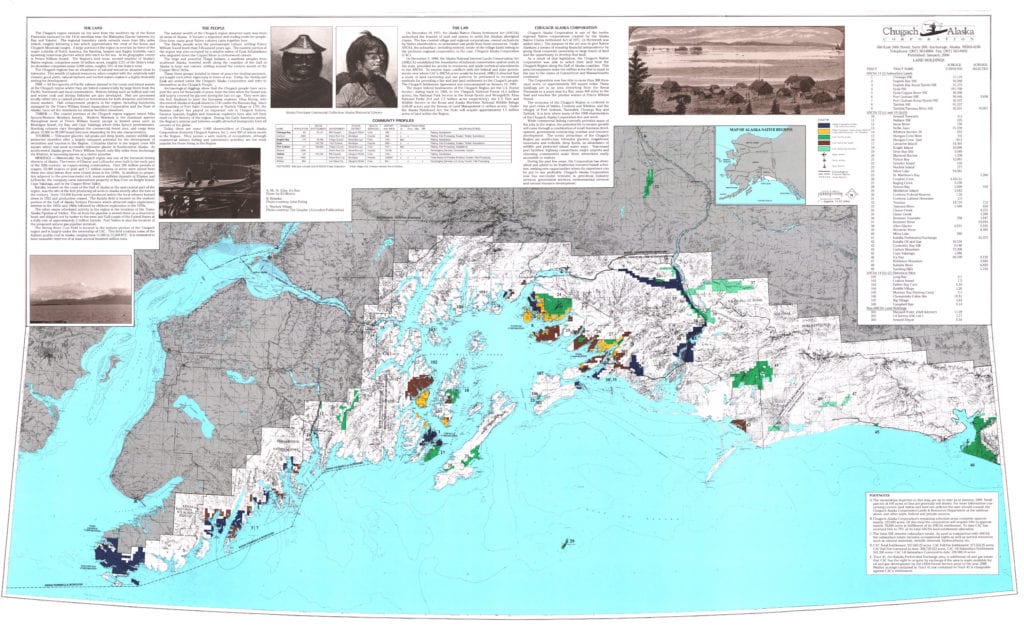
A proposed land exchange involving some 229,000 acres of Chugach Alaska Corp.’s subsurface estate began in earnest with the passage of an omnibus land act in Congress on March 12, 2019, but where it’s headed over the next two to 10 years remains unknown.
Some see the proposed exchange as a potential economic and cultural benefit to the Alaska Native shareholders whose ancestors have inhabited the area for thousands of years. Others feel that for environmental reasons these lands should be retired from potential development.
The omnibus legislation, the Dingell Act, includes a special section allowing for a land exchange. Such an exchange would, among other things, consolidate land holdings, resolving complex management issues CAC faces dealing with spit estates, where CAC owns the subsurface and the federal government owns the surface and has placed conservation easements on the land, said Josie Hickel, executive vice president of Alaska Native Claims Settlement Act and community affairs for CAC.
“In reality, the federal government cannot truly secure the land for conservation when Chugach owns the subsurface, which is the dominant estate,” she said.
CAC has been told, Hickel said, that the process to do an exchange could take at least two years, and perhaps more than 10 years. It depends on the complexity of the property, such as how much survey work has to be done, and other processes, she said.
Others, like Rick Steiner, a conservation biologist in Anchorage and former University of Alaska professor with a strong conservation interest in the area, have voiced concern that the process has not been public enough. Steiner sent a Freedom of Information Act request to the Bureau of Land Management on July 13 requesting all records discussing potential land exchanges between CAC, the Interior Department and the U.S. Forest Service. On Oct. 13, the BLM responded with 41 documents totaling 495 pages. The pages were heavily redacted, however, and Steiner has filed an appeal.
While the BLM is doing the required Chugach region land study, to identify potential lands for an exchange, the BLM would not conduct the actual exchange, which will probably come later through a separate environmental review.
“Currently as the act is written there is no requirement to actually do a land exchange,” said Lesli Ellis-Wouters, communications director for the BLM in Alaska. “If they want to direct one, it will require additional legislation. We are not studying an exchange at this point, only preparing for the possibility of an exchange.”
The BLM hopes to have the draft environmental assessment available later in February to host public meetings in conjunction with the proposed amendment, she said.
“One of our prime considerations for land exchanges is to acquire culturally significant lands in our region,” Hickel said.
Each potential exchange would then have to be looked at individually to consider public interest determinations. The COVID-19 pandemic and administrative delays in contracting the socio-economic part of the study have slowed the process, she said. The Chugach region land study was supposed to have been completed by November.
The amendment to the plan now under consideration is worrisome to the likes of Steiner, who supports a recent decision of the Exxon Valdez Oil Spill Trustee Council for expansion of restoration and habitat protection of areas of Prince William Sound devastated by the 1989 Exxon Valdez oil spill disaster. During its Jan. 19 meeting, the council approved a draft resolution extending the boundaries of the restoration zone mapped out in 1994 eastward to incorporate the Copper River Delta and the Bering River, including its headwaters, identifying where money from the $900 million settlement could be spent.
As the resolution itself states “the council, having spent considerable effort to successfully address the direct impacts of the 1989 oil spill is now in a position to address the broader spectrum of ecological impacts, including the adverse effects to ecosystem services and mobile fish and wildlife populations whose ranges overlap or intersect with the spill area.”
The decision was welcomed by Steiner and by Dune Lankard, founder of the Native Conservancy in Cordova.
According to Ellis-Wouters the BLM is in the final stages of completing its report which will be a public document once it is delivered to Congress.
“However, I imagine there will still be some review time to clear the Interior Department prior to its delivery to Congress,” she said.
Steiner wants more transparency now, before the documents go to the Interior Department and Congress. He questions why the Chugach National Forest plan revision recently completed by the U.S. Forest Service makes no mention of the potential swap of thousands of acres of land.
“Any significant change in management or disposal of Chugach National Forest lands now could compromise years of public process devoted to the Forest Plan just adopted, and thus is of considerable public interest,” he said
The region is also subject to the Exxon Valdez Oil Spill Restoration Plan and hundreds of millions of public funds have been spent in protecting private coastal habitat in the region, he said.
More specific information on the proposed land exchange is a matter of significant interest to the American public, he said.
"exchange" - Google News
February 05, 2021 at 09:52PM
https://ift.tt/3ryWRsl
Proposed Chugach Alaska land exchange could take years - The cordova Times
"exchange" - Google News
https://ift.tt/3c55nbe
https://ift.tt/3b2gZKy
Exchange
Bagikan Berita Ini















0 Response to "Proposed Chugach Alaska land exchange could take years - The cordova Times"
Post a Comment